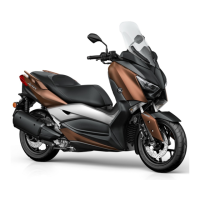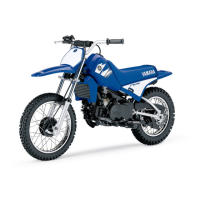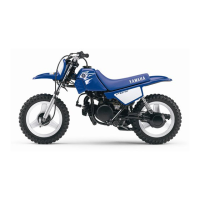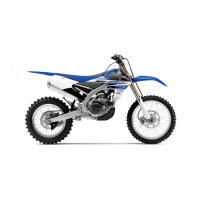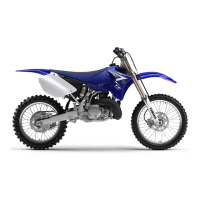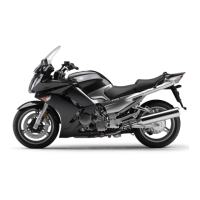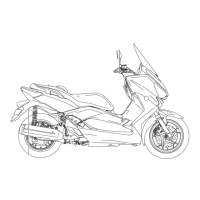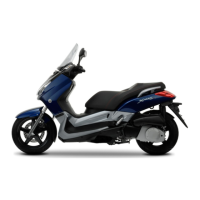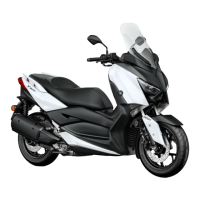Do you have a question about the Yamaha X-MAX 300 and is the answer not in the manual?
Owner's responsibility for safe operation and proper use of the scooter.
Importance of pre-operation checks and general riding safety.
Recommended gear for rider safety.
Risks of engine exhaust and precautions.
Functionality and basic operation of the smart key system.
Situations where the smart key system may not function correctly.
Defines the operational range of the smart key system.
Instructions for handling smart and mechanical keys.
How to turn the smart key on/off, check status, and use remote functions.
Steps for replacing the battery in the smart key.
How to operate the main switch for various functions.
How to lock/unlock the steering and engage parking mode.
Explanation of various indicator and warning lights on the instrument panel.
Identification and function of various handlebar switches.
How the Anti-lock Brake System (ABS) works and its operation.
How the traction control system works and its benefits.
Importance of understanding all controls before riding.
Step-by-step instructions for starting the engine.
How to safely start riding the scooter.
Safe braking procedures and considerations.
Guidelines for the initial break-in period of the engine.
Why periodic inspection, adjustment, and lubrication are essential.
Schedule for general maintenance tasks and lubrication points.
Steps for changing engine oil and replacing the oil filter element.
How to check and change the final transmission oil.
How to inspect tires and check/adjust air pressure.
Procedure for changing brake fluid and replacing seals/hoses.
Information about battery type, maintenance, charging, and storage.
Specific checks for when the smart key system does not work.
Flowcharts for diagnosing starting problems and poor engine performance.
How to operate the vehicle in emergency mode using the identification number.
How to find and record VIN, engine serial number, and model label.
Owner's responsibility for safe operation and proper use of the scooter.
Importance of pre-operation checks and general riding safety.
Recommended gear for rider safety.
Risks of engine exhaust and precautions.
Functionality and basic operation of the smart key system.
Situations where the smart key system may not function correctly.
Defines the operational range of the smart key system.
Instructions for handling smart and mechanical keys.
How to turn the smart key on/off, check status, and use remote functions.
Steps for replacing the battery in the smart key.
How to operate the main switch for various functions.
How to lock/unlock the steering and engage parking mode.
Explanation of various indicator and warning lights on the instrument panel.
Identification and function of various handlebar switches.
How the Anti-lock Brake System (ABS) works and its operation.
How the traction control system works and its benefits.
Importance of understanding all controls before riding.
Step-by-step instructions for starting the engine.
How to safely start riding the scooter.
Safe braking procedures and considerations.
Guidelines for the initial break-in period of the engine.
Why periodic inspection, adjustment, and lubrication are essential.
Schedule for general maintenance tasks and lubrication points.
Steps for changing engine oil and replacing the oil filter element.
How to check and change the final transmission oil.
How to inspect tires and check/adjust air pressure.
Procedure for changing brake fluid and replacing seals/hoses.
Information about battery type, maintenance, charging, and storage.
Specific checks for when the smart key system does not work.
Flowcharts for diagnosing starting problems and poor engine performance.
How to operate the vehicle in emergency mode using the identification number.
How to find and record VIN, engine serial number, and model label.
| Displacement | 292cc |
|---|---|
| Bore x Stroke | 70.0 mm x 75.9 mm |
| Compression Ratio | 10.9:1 |
| Maximum Power | 20.6 kW (28.0 PS) @ 7, 250 rpm |
| Fuel System | Fuel Injection |
| Ignition System | TCI |
| Transmission | V-Belt Automatic |
| Front Suspension | Telescopic fork |
| Rear Suspension | Unit Swing |
| Front Brake | Hydraulic single disc, Ø 267 mm |
| Front Tyre | 120/70-15 |
| Rear Tyre | 140/70-14 |
| Dimensions (L x W x H) | 2, 185 mm x 775 mm x 1, 415 mm |
| Seat Height | 795 mm |
| Wheelbase | 1, 540 mm |
| Ground Clearance | 135 mm |
| Wet Weight | 179 kg |
| Engine Type | Liquid-cooled, 4-stroke, SOHC, 4-valves |
| Maximum Torque | 29.0 Nm (2.96 kg-m) @ 5, 750 rpm |
| Fuel Tank Capacity | 13.0 liters |
| Rear Brake | Hydraulic single disc, Ø 245 mm |
